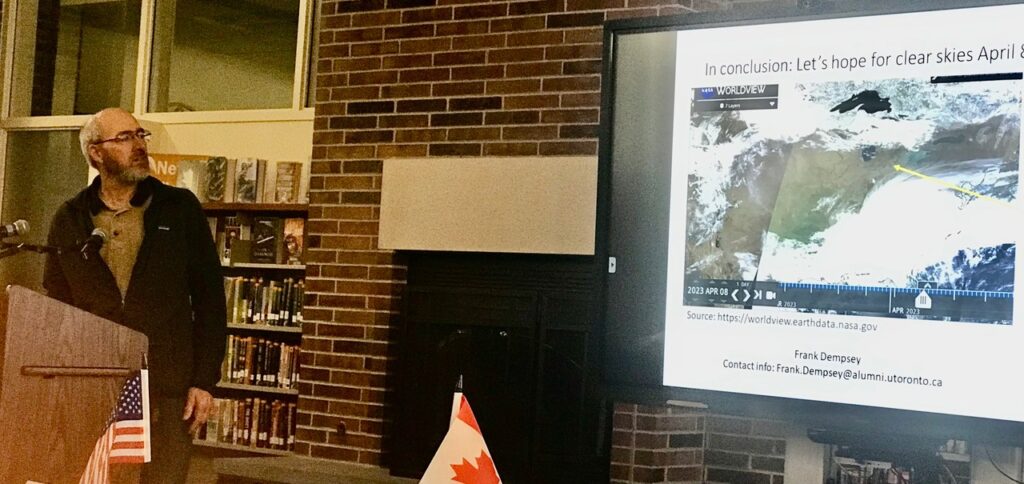By DAVID DUPONT
BG Independent News
BGSU’s Reddin Symposium in Canadian Studies this year turned its gaze not just northward but heavenward. “Solar eclipses will not respect our borders,” said Rebecca Mancuso, the BGSU history professor who hosted the event, which was offered as part of the weekly series of talks leading up to the April 8 total eclipse of the sun.
[Click to view video of the symposium]
Several scholars, two from Canada, spoke on eclipse-related topics. A thread throughout the two-hour event was the contrast between scientists and common people.
Keynote speaker Randall Rosenfeld, of the Royal Astronomical Society of Canada, said “the high emotions of an eclipse put those cultural borders in high relief.”
British astronomer and mathematician Sir George Biddell Airy was so moved by viewing he called it “inexpressively beautiful.” Rosenfeld said that “this contrasts with those who had a horror of totality.” Did people like Airy have sympathy for “cultures which were frightened to the core by the disappearance of the sun?”

BGSU scholar Amílcar Challú also addressed this gap in his brief remarks about Mexico, a preview of his March 21 talk in the eclipse speaker series. He spoke of a priest in Mexico in 1691. The priest expected the eclipse and was thrilled to experience it. He gave thanks to God for allowing him to witness it. But he noted that the people in the city square fled inside, afraid as the sun disappeared.
Rosenfeld viewed the Canadian experience of solar eclipses through six artifacts, “old stuff” that has a direct connection to humans’ experience of a total solar eclipse.
Among those was a replica of a telescope used by a missionary to view the eclipse in 1642.
These objects, Rosenfeld said, often pose questions as much as answer them. Did any of the Huron look through the apparatus?
Another artifact also touched on indigenous culture. A Toronto accountant recorded his observations of a 1900 eclipse on birch bark. Rosenfeld wondered if this evocation of indigenous culture was “elegiac” or “triumphalist.”
Notes on an eclipse a 19th century eclipse were written on the back of a founding document of the Royal Astronomical Society itself. While “it captures the immediacy of the experience,” he said, it is akin to taking notes on the back of Constitution.
In the early 20th century, enthusiasts began to organize expeditions to view total eclipses. These involved great expense and preparation, and the risk that the weather would make viewing it impossible.

Sarah Reynolds, from the University of Indianapolis, spoke about how the experience of eclipses help shape modern scientific method.
People have long studied the skies because what happened there was important to their everyday lives, she said. Celestial occurrences helped ancient people know when to plant and how to navigate. Eclipses disrupted the predictability of these observations. An eclipse forces people to reconsider what they thought they knew. It forces them to consider another reality, a world both colder and darker. This prompts them to question: Is this going to happen again? And how will we know? These helped shaped the pursuit of scientific knowledge.
Evolving technology, she noted, also changed the way the phenomenon was recorded. She show an image of an ancient petroglyph from Hovenweep National Monument in Colorado that documents a solar eclipse. Later eclipses would be broadcast on radio and captured on film.
The writer and amateur astronomer Mabel Loomis Todd observed: “Ordinary people are better able to enjoy an eclipse because scientists are busy.”
Frank Dempsey, a retired meteorologist, amateur astronomer, and member of the Dokis First Nation, emphasized the importance of close observation. Some people can just look at a natural wonder and walk away. Others see far more details and garner more information.
Dempsey speculated that some native people could have been able to predict a coming eclipse without the aid of mathematics.
Dempsey offered a guide of what to look for to solar eclipse viewers:
- Crisp shadows as crescent solar disk gets thin.
- Decreasing air temperature, decreasing bird activity.
- Moon’s shadow moving across the sky before totality.
- Increasing twilight colors.
- Shadow bands on the ground.
- Nearby planets (and comet, maybe).
- Solar corona.
The next in the series will be tonight (Thursday, March 7) at 7:30 p.m. in the BGSU planetarium when Colin Hochstetler, music researcher in the BGSU Music Library and Bill Schurk Sound Archives, will speak on “Sounds of the Solar Eclipse: Exploring the Music of Solar Eclipse Demonstrations in Planetariums.”
A planetarium show precedes the talk at 6:30 p.m.

